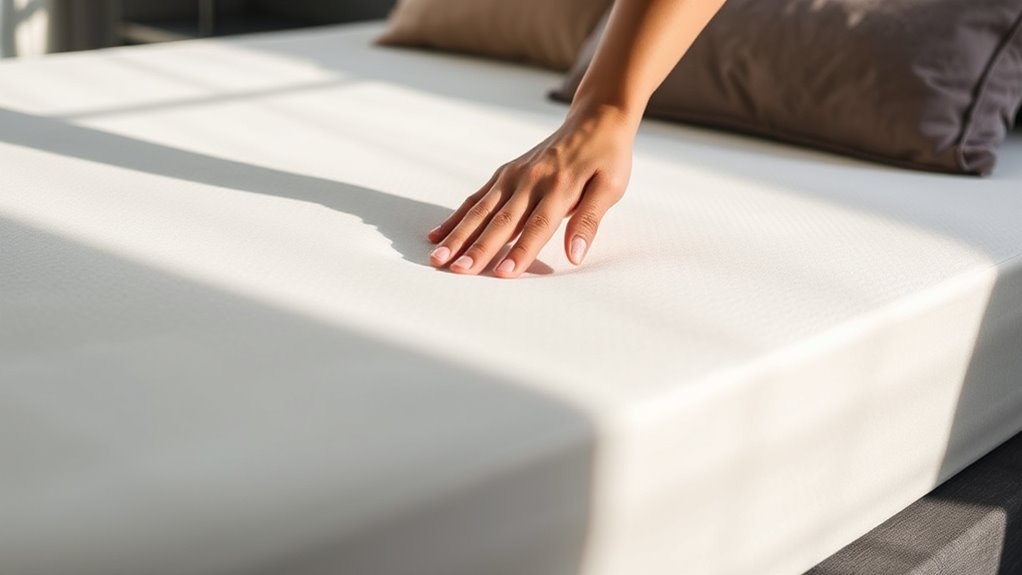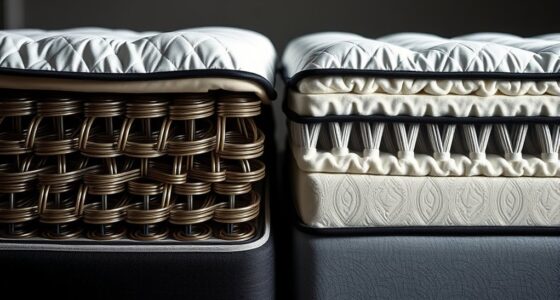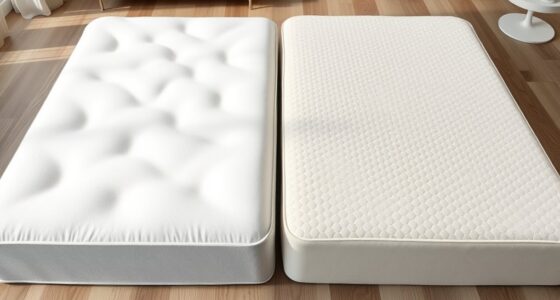Memory foam mattresses offer great support and conform closely to your body, helping reduce pressure points and improve spinal alignment. However, they can trap heat, making it less comfortable if you tend to sleep hot. The response time is slower, which might cause you to feel stuck during turns, and newer models may off-gas initially. While they tend to be more expensive and durable, understanding these pros and cons guarantees you select the right fit for better sleep—stay tuned to learn more.
Key Takeaways
- Memory foam offers personalized support and pressure relief, improving comfort and spinal alignment.
- It can trap heat, causing discomfort, but gel cooling technology helps regulate temperature.
- Some mattresses have softer edges, which may reduce support and stability around the perimeter.
- Response time may be slow, leading to a feeling of being stuck; off-gassing can produce strong odors initially.
- Generally more expensive, high-quality models provide durability and enhanced features, offering better long-term value.

Are you curious about whether a memory foam mattress is the right choice for your sleep needs? If so, you’re not alone. Many people consider memory foam for its comfort and pressure relief, but it’s important to weigh the pros and cons before making a decision. One of the biggest advantages is its ability to conform to your body, providing excellent support and minimizing pressure points. This makes it a popular choice for those with joint pain or back issues. However, traditional memory foam can trap heat, leading to uncomfortable nights. Luckily, newer models often feature gel cooling technology, which helps regulate temperature and keeps your sleep environment more comfortable. If overheating has been a concern for you, look for a mattress with gel cooling layers—these are designed to dissipate heat and improve airflow, making sleep cooler and more restful. Additionally, advancements in neural network integration have led to the development of smarter cooling systems that adapt to your body temperature throughout the night, enhancing overall sleep quality.
Edge support is another key factor to consider. Some memory foam mattresses tend to have softer edges, which can make it difficult to sit or sleep near the perimeter without feeling like you might roll off. But many modern memory foam designs now incorporate reinforced edges, offering better edge support. This means you can use the entire surface of the mattress without feeling unstable or risking a fall. If you tend to sit on the edge of your bed or share your mattress with a partner, good edge support can make a noticeable difference in your comfort and overall usability.
On the downside, memory foam mattresses often have a slower response time. When you change positions, it might take a moment for the foam to adjust, which can sometimes cause a feeling of being stuck or trapped. If you’re a person who moves frequently during sleep, this could be frustrating. Additionally, some memory foam mattresses have a strong scent when new, known as off-gassing, which can be bothersome for sensitive sleepers. While this smell typically dissipates within a few days, it’s something to keep in mind when unboxing your new mattress.
Price can also be a consideration. High-quality memory foam mattresses with gel cooling and reinforced edges tend to be more expensive, but they often come with longer warranties and better durability. Keep in mind that investing in a good quality mattress can pay off in improved sleep quality and comfort over the years. Overall, memory foam offers fantastic support and pressure relief, especially with modern features like gel cooling and enhanced edge support. However, it’s essential to weigh your specific sleep preferences and needs to determine if it’s the right fit for you.
Frequently Asked Questions
Are Memory Foam Mattresses Suitable for Hot Sleepers?
If you’re a hot sleeper, memory foam mattresses might not be your best choice. They tend to trap heat, making temperature regulation difficult. While some modern memory foam mattresses feature gel infusions or breathable covers, traditional versions lack adequate breathability. You may find yourself feeling sweaty or uncomfortable at night. Look for options with enhanced airflow and cooling features to improve comfort and sleep quality if temperature regulation is your priority.
How Long Do Memory Foam Mattresses Typically Last?
Think of your memory foam mattress as a loyal companion—its lifespan depends on durability factors like quality, usage, and maintenance. Typically, you can expect it to last around 7 to 10 years, but poor care or lower-quality materials might shorten that. To maximize its lifespan, rotate it regularly and keep it well-ventilated. With proper care, your mattress remains a restful retreat for many years.
Can Memory Foam Mattresses Cause Allergies?
You might wonder if memory foam mattresses can cause allergies. If you’re sensitive to chemicals or latex allergies, these mattresses could trigger reactions due to the chemicals used in manufacturing. Chemical sensitivities are common, and some memory foam beds emit volatile organic compounds (VOCs). To diminish risks, look for hypoallergenic or CertiPUR-US certified options, and ensure good ventilation. Always check labels if you have known latex allergies or chemical sensitivities.
Do Memory Foam Mattresses Require Special Maintenance?
A memory foam mattress is like a delicate garden needing tender care. You should follow specific care instructions and cleaning methods to keep it in top shape. Regularly vacuum the surface to remove dust and spot-clean stains with a mild detergent. Avoid soaking it or using harsh chemicals. Proper maintenance guarantees your mattress stays comfortable and extends its lifespan, making sure you sleep soundly for years to come.
Are Memory Foam Mattresses Eco-Friendly?
You might wonder if memory foam mattresses are eco-friendly. While memory foam’s sustainability depends on the manufacturing process, some brands use eco-friendly methods and recycled materials to reduce environmental impact. Look for certifications indicating eco-friendly manufacturing practices. Although traditional memory foam isn’t fully sustainable, choosing brands committed to eco-conscious production helps minimize your carbon footprint and supports more sustainable options in bedding.
Conclusion
Think of choosing a memory foam mattress like planting a tree. At first, it may seem soft and inviting, offering comfort and support. But as you grow with it, you’ll find its roots—its pros—support your body perfectly. Still, beware of the occasional thorns—like heat retention or off-gassing. Weigh the benefits and drawbacks carefully, and you’ll find the perfect spot for restful nights ahead. Your ideal sleep sanctuary awaits—just like a well-tended tree.









